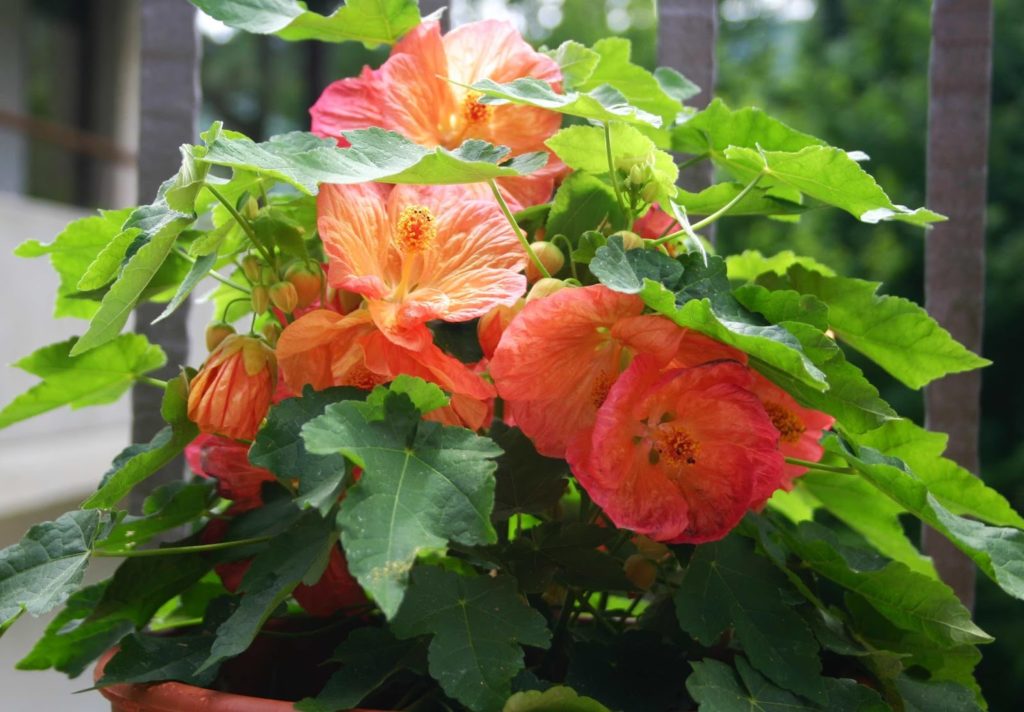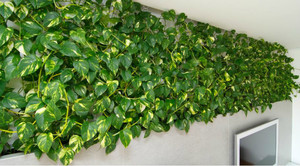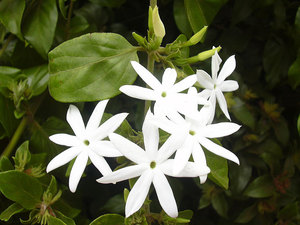 The jasmine plant is a multi-stemmed shrub, reaching a height of up to 4 meters. It comes in different colors. Has snow-white or delicate creamy flowers and whole leaves. It is unpretentious, blooms profusely.
The jasmine plant is a multi-stemmed shrub, reaching a height of up to 4 meters. It comes in different colors. Has snow-white or delicate creamy flowers and whole leaves. It is unpretentious, blooms profusely.
The bush has a sweet, refreshing aroma. Having planted different types of jasmine bushes, you can observe its charming flowering and inhale the fragrant scent for a month.
Jasmine shrub is revered in the countries of the East. It is considered a symbol of love and passion. From the flowers of the plant, an essential oil is produced that can relieve anxiety, stress, anxiety, depression, anxiety, and raise the hormonal status. His actively used in cosmetology, perfumery, added to shampoos, creams, perfumes, lotions.
In addition to beauty and rich aroma, it has another positive quality - it attracts insects to the garden - pollinators: butterflies, bees, bumblebees.
The garden plant is also popularly called the chubushnik. It is the most popular flowering perennial. It has small flowers. The second name was given for the fact that shanks for smoking pipes were made from its strong wood in Russia. The chubushnik fruit is a three or five-sided box with very small seeds.
Jasmine varieties
The most popular forms of jasmine are considered by gardeners:
 Common jasmine. A large tree, reaching 3 m in height, the flowers have a white or creamy, strong aromatic smell.
Common jasmine. A large tree, reaching 3 m in height, the flowers have a white or creamy, strong aromatic smell.- Small-leaved jasmine. A small tree with semi-double or double flowers. Placed in the foreground of the garden area. It can be found next to paths, verandas, benches and gates.
- Fluffy jasmine. It has the shape of a bush or a small tree, it can reach a height of 4 meters. The flowers are soft cream, with a slight scent.
As a result of crossing these three species, scientists managed to obtain several new varieties of jasmine: "Etheronos", "Glacier", "Alabaster", "Ermine mantle", "Airborne landing".
Landing
In order for this shrub to take root and bloom profusely, it is necessary to correctly approach the choice of location and preparation of the soil. It is necessary to ensure that the distance from the roots to the walls of the hole is about 10 cm. Sprinkle the roots of the seedling with earth. To deepen the root collar by 3 cm, but no more. Water abundantly.
Seat selection
A site for a plant can be distinguished on the south side, but it will bloom on the north, as well as in the shade. But we must remember that the shrub on the sunny side will grow faster. The plant does not like stagnant groundwater or even their close approach.
Boarding time
Spring or autumn is ideal for planting a plant. It is at this time of the year that the kidneys do not yet have time to open. Experts for planting jasmine recommend choosing September - October.
Soil preparation
The plant survives well on any soil, but gives preference to fertile soil. Before planting, the earth must be dug up carefully. The hole must be at least half a meter deep. It is necessary to add nitrophoska to it at the rate of 30 g per 1 seedling. Drainage is prepared from gravel, sand, bricks and rubble.
Reproduction
The shrub is propagated in the following ways:
- dividing the bush;
- cuttings;
- layering;
- seeds.
Seeds are sown at any time of the year in open ground. Winter sowing should be in calm weather. The temperature should not be below -10 degrees.The seeds are covered with straw and coniferous branches. In the spring, the shelter is removed, and the seedlings are protected from direct sunlight.
Cuttings are harvested in the fall, stored throughout the winter in the basement. They are planted in the soil in early spring. As soon as the cuttings grow up, they must be spud to accelerate the growth of the root system.
For the formation of layers in early spring, young shoots are taken. They are laid out in the beds and sprinkled with earth. When new shoots appear, the layers are spud. In autumn, they are separated from the main bush.
Dividing a bush is a simple and common way to propagate a bush. It is necessary to carefully divide the dug root system without damaging it. Plant parts of jasmine in different parts of the site.
Care
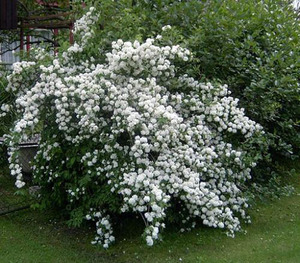 Jasmine bushes will decorate the garden and delight with abundant flowering, subject to certain care rules:
Jasmine bushes will decorate the garden and delight with abundant flowering, subject to certain care rules:
- Loosen the soil around the bushes weekly, remove weeds.
- Fertilize with organic and mineral fertilizers.
- Periodically shape the bushes by pinching their tops.
Watering
Jasmine requires abundant watering, especially when the weather is dry. It is absolutely impossible to allow the soil to dry out. Jasmine leaves will lose their turgor and turn yellow. For 1 square meter of soil, at least 30 liters of water is required for irrigation.
Top dressing
The first plant feeding is done only 10-12 months after planting. This plant is fed only with mineral and organic fertilizers.
30 g of superphosphate and 15 grams of urea and potassium are stirred in a bucket of water. This top dressing is enough for two bushes.
Manure slurry can be used as an organic fertilizer. It is diluted in water (1:10).
Preparation for wintering
Jasmine is not afraid of low temperatures, so it is not required to specially prepare the plant for winter. Only young plants should be covered. They are covered with a light-colored cloth and tied with a rope.
Pruning
Jasmine needs to be pruned regularly to give it a neat look. Sanitary and cosmetic pruning is performed annually. The bushes are thinned out, dried flowers, excess shoots are removed in the fall, dry branches and shoots thickening the crown, as well as painful and broken ones, are removed. Once every three years, shoots that are more than 12 years old are removed.
A rejuvenating pruning of the plant is also required. Plants are pruned in spring to 0.5 meters. When the stems are cut, the cut sites are treated with garden varnish to prevent fungal diseases.
Disease and pest control
Jasmine needs to be protected from aphids, spider mites, weevils, thrips, soft pseudo-scale insects, mealybugs. The shrub is sprayed with insecticides to remove pests.
Folk remedies also help: a solution of laundry soap, ash.
Jasmine in landscape design
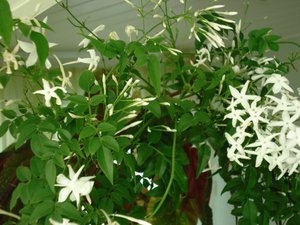 Jasmine in garden plots is used for large mixborders. Dwarf plant varieties look great in rock gardens, rocky gardens. They are planted as borders and edging for flower beds.
Jasmine in garden plots is used for large mixborders. Dwarf plant varieties look great in rock gardens, rocky gardens. They are planted as borders and edging for flower beds.
Jasmine is excellent combined with lilac, hydrangea, weigeloy... To create a hedge, designers combine several varieties of jasmine.
It looks good in composition with other plants, decorating a gate, a wall of a house or a bench.
Jasmine is a gorgeous shrub whose flowers can decorate not only a garden plot, but also a home.
Important! There are varieties of jasmine that are covered with flowers twice a season. And low jasmine, used to decorate rock gardens, may not give flowers. Therefore, for people with allergies, it is advisable to start just undersized species.
In addition to its beauty and rich aroma, jasmine has another positive quality - it attracts pollinating insects to the garden: butterflies, bees, bumblebees.
